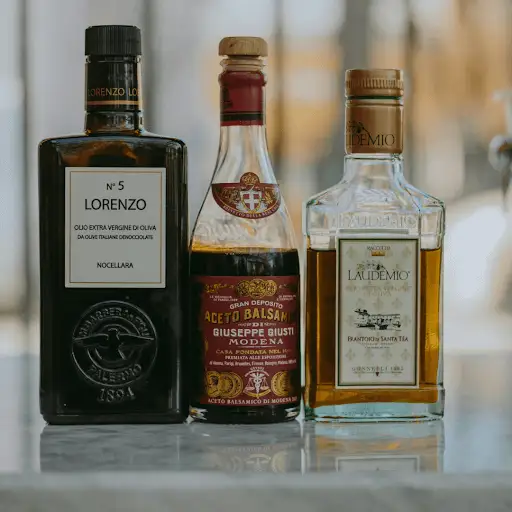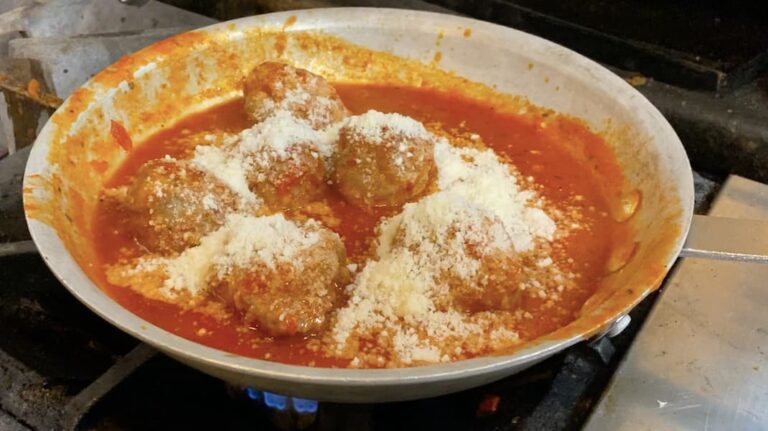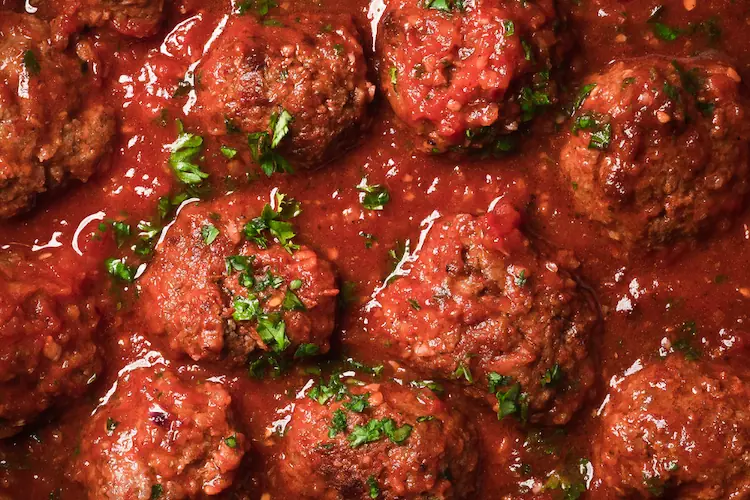Balsamic vinegar is a staple in my kitchen.
I’ve got multiple bottles at that I use for different things, whether it’s for a salad dressing or even a dessert.
Yes, dessert! We’ll get to that later.
First, let’s dive into what exactly balsamic vinegar is, how it’s made, how to use it, and so much more.
What is Balsamic Vinegar?
Balsamic vinegar is more than just a condiment; it is a symbol of Italian heritage and culinary tradition. particularly from the Modena and Reggio Emilia regions. This aged vinegar, known for its thick syrup-like consistency and complex flavor. From its roots deep in Italian history, it has become a staple in kitchens worldwide.
Balsamic vinegar is traditionally made through a labor-intensive process that spans decades! It was once a treasured secret kept by the Italian aristocracy, used both as a medicinal elixir and a prestigious gift.
The Historical Origins of Balsamic Vinegar
Balsamic vinegar has a fascinating backstory that takes us to the picturesque northern Italian regions of Modena and Reggio Emilia. Believe it or not, its history stretches all the way back to the Middle Ages.
Back then, it wasn’t just another ingredient on the shelf; it was a treasured elixir, valued by nobles for its supposed health benefits. It could do everything from aiding digestion to being a general cure-all. It was such a prized possession that it often found its way into the royal courts as a fancy gift or even as a diplomatic gesture.
Even with all the modern advancements we have today, the way traditional balsamic vinegar is made hasn’t changed much. The balsamic vinegar artisans stick to the old ways—using high-quality grape must, letting it ferment naturally, and then patiently aging it in a series of wooden barrels.
This commitment to the traditional methods helps preserve the deep, complex flavors that make balsamic vinegar so special. Keeping these age-old techniques alive not only celebrates its rich flavor but also keeps a piece of Italian culinary history going strong in our kitchens today.
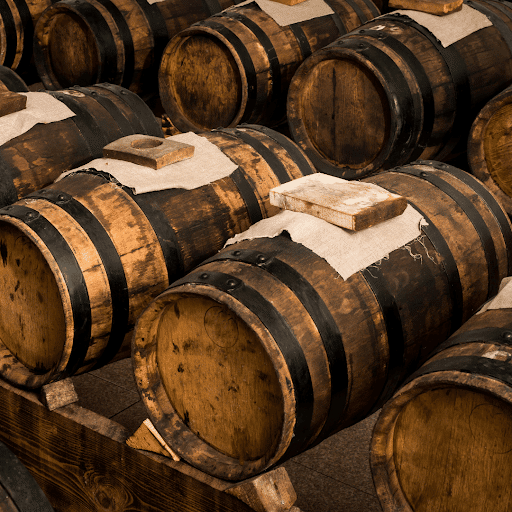
Traditional vs. Commercial Balsamic Vinegar
Today, there are primarily two types of balsamic vinegar: Aceto Balsamico Tradizionale, which adheres to strict traditional methods, and the more widely available commercial balsamic vinegars.
Traditional Balsamic Vinegar of Modena DOP and Traditional Balsamic Vinegar of Reggio Emilia DOP are made exclusively from cooked grape must—primarily from Trebbiano and Lambrusco grapes—without any additional vinegars or additives.
On the other hand, commercial “Balsamic Vinegar of Modena IGP” often contains a mix of wine vinegar and a substantial percentage of concentrated grape must, with colorants like caramel coloring and thickeners such as guar gum or xanthan gum to mimic the consistency and sweetness of their traditional counterparts.
It’s fascinating how these variations impact their flavor and texture. Traditional balsamic vinegar, like Aceto Balsamico Tradizionale from Modena or Reggio Emilia, offers a more complex and rich flavor profile with a smooth, syrupy texture that coats the palate beautifully. This is due to its pure grape must content and lengthy aging process in various wooden barrels.
On the other hand, commercial balsamic vinegars, which often include a blend of wine vinegar and grape must concentrate, tend to have a sharper acidic taste and a thinner consistency. The caramel coloring and thickeners in these varieties are added to replicate the darker color and thicker texture of traditional balsamic. Unfortunately, this can sometimes lead to a slightly artificial sweetness or glossiness that distinguishes it from the deep, natural sweetness of traditional balsamic vinegar.
Geographical Indication and Designation of Origin
You’ve probably noticed different stickers on your balsamic vinegar. When you see DOP (Denominazione di Origine Protetta) and IGP (Indicazione Geografica Protetta) labels on a bottle of balsamic vinegar, you know you’re getting the real deal. These labels are like a seal of approval from the European Union, ensuring that the product is genuine.
The DOP label tells you that everything about the product—from where it’s made to how it’s made—sticks strictly to traditional methods and local ingredients. On the flip side, the IGP label zeroes in on the geography, ensuring that at least one stage of the production process happens in a specific area. These protections help keep the classic balsamic vinegar traditions alive and well, right where they started in Modena and Reggio Emilia.
The Production Process: A Labor of Love
Making traditional balsamic vinegar is truly a labor of love and a test of patience. It can take anywhere from 12 to over 25 years to get it just right!
The journey starts with picking the perfect wine grapes, which are then crushed to squeeze out the fresh juice, called must. This juice is cooked over an open flame until it thickens into a rich syrup. Next, it undergoes a slow fermentation process where the natural sugars gradually turn into alcohol and then into acetic acid.
But that’s just the beginning. The real magic happens during the aging process. The vinegar is moved through a series of wooden barrels, each made from different types of wood like oak, chestnut, cherry, ash, and mulberry, which all add their own unique flavors to the mix.
The smallest barrel in the lineup plays a crucial role—it’s where the vinegar gets its final flavor boost and becomes more concentrated as some of it evaporates, getting richer and more complex as time goes by. It’s a long wait, but the end result is definitely worth it!
Culinary Uses of Balsamic Vinegar
Balsamic vinegar offers a unique flavor that enhances many dishes. Its rich, slightly sweet profile makes it perfect for salad dressings when combined with olive oil and herbs. Aged balsamic vinegar can be drizzled over fruits like strawberries and desserts like vanilla ice cream, adding a nice depth of flavor. In savory dishes, it pairs wonderfully with red meats, and a few drops can easily elevate the taste of grilled fish or roasted vegetables.
Here are some food pairings with balsamic vinegar:
- Strawberries and Cream: Drizzle balsamic vinegar over fresh strawberries with a dollop of whipped cream or vanilla ice cream for dessert.
- Caprese Salad: Enhance this classic Italian salad of fresh mozzarella, tomatoes, and basil by finishing with a balsamic reduction.
- Grilled Meats: Brush balsamic vinegar on grilled chicken, steak, or pork to add a rich, caramelized flavor.
- Roasted Vegetables: Toss vegetables like brussels sprouts, carrots, or sweet potatoes in balsamic vinegar before roasting to enhance their natural sweetness.
- Cheese Pairings: Pair a drizzle of aged balsamic with robust cheeses such as Parmesan, Gorgonzola, or goat cheese for a striking flavor contrast.
- Seafood: Splash a bit of balsamic vinegar on grilled salmon or scallops to add a touch of brightness and depth.
- Pizza: Upgrade your pizza by adding a few drops of balsamic vinegar on top, especially on pies with arugula, prosciutto, and mozzarella.
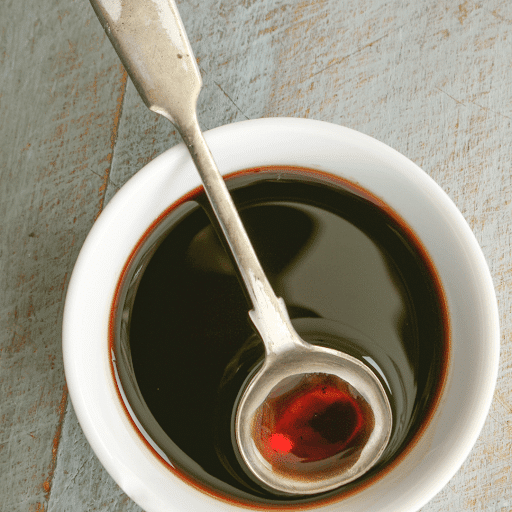
Buying and Storing Balsamic Vinegar
When purchasing balsamic vinegar, it’s crucial to read the labels carefully. Authentic balsamic vinegar will have the DOP or IGP mark, indicating its quality and origin. Once you get it home, it should be stored in a cool, dark place. Ideally, balsamic vinegar comes in a small bottle to minimize air exposure, which can affect its quality.
Health Benefits of Balsamic Vinegar
Balsamic vinegar is more than just a tasty addition to your kitchen. It’s packed with perks for your health too! Loaded with antioxidants like polyphenols, balsamic vinegar can help knock out harmful inflammation and oxidative stress in your body, potentially keeping diseases like heart disease and cancer at bay.
It’s also got acetic acid, which boosts digestion and might even keep your blood sugar levels from skyrocketing after meals. Plus, it’s low in calories, so you can splash it on your salads or dishes to ramp up the flavor without piling on the pounds. All in all, balsamic vinegar is a super easy (and delicious) way to give both your meals and your health a boost.
What is White Balsamic Vinegar?
White balsamic vinegar offers a twist on the traditional dark variety—it’s lighter in color and flavor, making it a subtle choice for dishes where you might not want the stronger, darker tones to dominate. Made from the same grapes as traditional balsamic, white balsamic is cooked at a lower temperature to prevent caramelization, keeping its color clear and its flavor milder and slightly sweeter.
It’s aged for a much shorter time compared to the classic version, which also contributes to its lighter color and less intense flavor. This makes white balsamic perfect for drizzling over fresh fruits, making dressings, or adding a gentle tang to sauces without altering the visual presentation of your dishes.
What about other Types of Vinegar?
Balsamic vinegar stands out in the world of vinegars thanks to its unique production process, history, and distinct flavor profile. Unlike other vinegars like apple cider or white wine vinegar, which are typically sharper and have a clearer, more straightforward tartness, balsamic vinegar offers a complex, slightly sweet flavor due to the aging process and the quality of the grape must used.
It’s also thicker and darker in color, which makes it not just a flavor enhancer but also a decorative drizzle for various dishes. This versatile vinegar can transform simple dishes into something truly special with just a few drops.
Here’s how balsamic vinegar stacks up against other popular vinegars:
- Apple Cider Vinegar: Sharper, with a fruitier edge; great for detox drinks and vinaigrettes.
- White Wine Vinegar: Lighter and less complex; ideal for seafood dishes and lighter sauces.
- Red Wine Vinegar: Bold and robust; perfect for hearty stews and marinades.
- Rice Vinegar: Mild and slightly sweet; essential in Asian cuisine, especially for sushi and salad dressings.
- Distilled White Vinegar: Very sharp and potent; commonly used for pickling and cleaning, rather than direct food seasoning.
Balsamic vinegar is a testament to the tradition of Italian vinegar making. From its royal beginnings to its current status as a kitchen staple, the journey of balsamic vinegar reflects a deep respect for time-honored production methods and the geographical specialties of the Modena and Reggio Emilia regions.
Whether used in simple everyday cooking or as a delicate addition to special dishes, balsamic vinegar continues to captivate the palates of food lovers around the world with its unique flavor and rich history.

